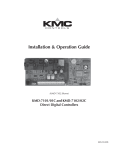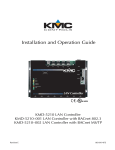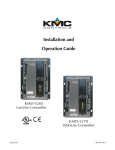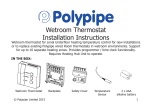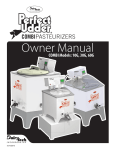Download Coleman 3000 SERIES Specifications
Transcript
Pneumatic VAV Reset Volume Controllers CSC-3000 Series* Applications Guide *NOTE: This Application Guide does not apply (completely) to the CSC-3014 or the CSC-3501/3505. See their separate data sheets and installation guides. General Information...................................................................................................... 2 CSC-3000 Series Overview............................................................................................................................................. 2 Mounting........................................................................................................................................................................ 2 More Information........................................................................................................................................................... 2 Connections................................................................................................................................................................... 3 Adjustments and Calibration.......................................................................................................................................... 4 Damper Action......................................................................................................................................................... 4 Determining the Type of Reset................................................................................................................................. 4 Adjusting Minimums and Maximums....................................................................................................................... 4 DIRECT Reset Minimum and Maximum................................................................................................................... 4 REVERSE Reset Minimum and Maximum................................................................................................................. 5 Reset Start Point....................................................................................................................................................... 6 Reset Span................................................................................................................................................................ 6 Troubleshooting.............................................................................................................................................................. 7 Maintenance................................................................................................................................................................... 7 Important Notices.......................................................................................................................................................... 7 Magnehelic Gauge to Airflow Rate Chart....................................................................................................................... 8 Replacement Cross-References....................................................................................................................................... 9 Applications................................................................................................................. 10 Cooling......................................................................................................................................................................... 10 Cooling with Heating Valve.......................................................................................................................................... 11 Cooling with Heating P-E Switch.................................................................................................................................. 12 Dual Duct..................................................................................................................................................................... 13 Dual Duct, Constant Volume........................................................................................................................................ 14 Index............................................................................................................................ 15 CSC-3000 Series Pneumatic VAV Reset Volume Controllers 1 Applications Guide, Rev G General Information CSC-3000 Series Overview Mounting These CSC-3000 series reset volume controllers are designed for use on heating or cooling systems with (normally open or normally closed) VAV terminal units and (direct or reverse acting) thermostats. The CSC-3000 Series are position sensitive. They must be mounted and calibrated in either the horizontal or vertical plane. 1. As near to the flow sensor pickup as is feasible, connect the mounting bracket to the mounting surface with two self-threading screws in the two 3/16" (5 mm) mounting holes. Be sure to leave enough room to make connections. 2. Insert the controller, face down, up, right or left. The controller must be installed and adjusted in the same plane or readjustment will be necessary. They are sub-master air velocity controllers. Each is equipped with separate adjustment knobs for minimum and maximum airflow setpoints. Models are available with various reset start points. A master controller, typically a room thermostat, resets the CSC-3000 between the minimum and maximum velocity setpoints. The universal design of the CSC-3000 series is intended for new or replacement applications that call for direct or reverse acting reset on normally open or normally closed VAV terminal units. More Information For specifications, see the CSC-3000 Series Data Sheet. NOTE: These controllers are used on single and dual duct applications. When working on dual duct applications, it may be necessary to work on one duct at a time. This Application Guide does not apply (completely) to the CSC-3014 (designed to work with CTC2100 Thermostats) or the CSC-3501/3505 (Linear Volume Reset Controllers). See their separate data sheets and installation guides. NOTE: Any sequencing with other controllers, valves, or pneumatic-electric relays must be done with the controller’s reset range, NOT the actuator’s spring range. All adjustments are CCW to increase For adjusting start point and span (upper and lower knobs) review the respective sections All dimensions are in inches (mm). CSC-3000 Series Pneumatic VAV Reset Volume Controllers 2 Applications Guide, Rev G Connections For all models of the CSC-3000 series, use 1/4" (5 mm) O.D. “FR” tubing on the following push-on fittings: NOTE: You can easily test for leaks with a squeeze bulb to ensure there are no leaks at the actuator diaphragm or fittings. 1. Connect the clean, dry, oil-free main air supply to Port “M” (15 to 30 psi). 2. Connect the damper actuator to Port “B.” 3. Connect the thermostat output to Port “T.” 4. Connect the high (“total”) pressure tap on the airflow sensor to Port “H.” 5. Connect the low (“static”) pressure tap on the airflow sensor to Port “L.” 6. Check for proper connections. Make sure all tubes are snug on their fittings. If loose, trim the end of the tubing and reconnect it to ensure there are no leaks. 7. Use a flow hood or “tee” a Magnehelic® (or equivalent) differential pressure gauge between the controller and the ∆P pick-up to determine airflow rates. CAUTION To prevent damage to the gauge, do NOT connect a Magnehelic gauge designed to measure an air flow sensor’s differential pressure (e.g., 0–0.5 wc) to the main air pressure (approximately 20 psi or 554 wc)! CAUTION NOTE: Over time, the tube may stretch or develop microcracks. Trim the end of tube back to undamaged material and reconnect. Replace the tubing if it is brittle or discolored. Pneumatic devices must be supplied with clean, dry control air. Any other medium (e.g., oil or moisture contamination) will cause the device to fail. NOTE: These instructions do not apply to the CSC3014 or the CSC-3501/3505. Magnehelic gauge and 0–30 psi gauge in illustration added for checkout and calibration purposes Typical CSC-3011 Application and Connections CSC-3000 Series Pneumatic VAV Reset Volume Controllers 3 Applications Guide, Rev G Adjustments and Calibration NOTE: Do NOT adjust reset start point and reset span (upper and lower knobs) without thoroughly reviewing the relevant sections. DIRECT Reset Minimum and Maximum Reset Span (5 psig) Reset Start Point • 3 psig: CSC-3021/3026 • 8 psig: CSC-3011/3016/3017/3025 • 10 psig: CSC-3023 Damper Action The damper action is factory-set at Normally Open (N.O.). To change to Normally Closed (N.C.), perform the following steps: Min. Airflow Thermostat Pressure For Direct Reset (DA thermostat for cooling or RA thermostat for heating), perform the following steps: 1a.On the CSC-3000, disconnect the “T” port and leave it open. Temporarily plug the tubing (but do NOT plug the port). 1b.Alternately, instead of removing the tubing from the T port, (temporarily) remove the plug from the CSC3000’s “G” port. 2. Adjust the LO STAT ∆P (center dial) one adjustment at a time until the desired Minimum airflow is read at the Magnehelic gauge and is stable. NOTE: Adjust the dial no more than about a half rotation at a time. After making any adjustment, wait approximately ten seconds while watching for motion in the damper shaft. If no motion occurs, make the next adjustment. 3. Tighten the selection screw. Be sure the screw is tight (2 to 4 in-lbs. of torque), but if overtightened, the plastic will strip out. Determining the Type of Reset The following table shows when Direct Reset or Reverse Reset is required. Determine the reset type based on the temperature of the primary air entering the VAV box and whether the thermostat in the space is direct or reverse acting. Cooling Heating Thermostat Reset Type DA Direct Reset RA Reverse Reset DA Reverse Reset RA Direct Reset NOTE: IF the LO STAT ∆P Limit must be set at “0” (zero minimum), do not turn the LO STAT ∆P knob fully clockwise. The knob will adjust one and one-half turns after a zero minimum is reached. Turning the LO STAT ∆P knob fully clockwise will result in a negative reset condition. This means that when the controller begins to reset at the reset start point, it must first overcome the negative adjustment and will not begin to reset from “0” until a higher thermostat reset pressure is reached. This negative reset will also reduce the effective range of the controller by reducing the low end reset, narrowing the reset span. If a zero minimum is required, adjust the LO STAT ∆P knob until the controller just begins to crack the damper open, and then back-off one-quarter turn and verify zero airflow. (This is typically 2-1/2 knob rotations counterclockwise from the fully clockwise position.) Adjusting Minimums and Maximums When adjusting the minimum and maximum airflow settings, the output responds slowly to changes in the setpoint. Wait for the flow rate to stabilize after making an adjustment (usually 20 to 30 seconds) before making further adjustments. Also, if the damper position is all the way closed or open when starting this step, turn the adjustment one full turn, and then wait 20 to 30 seconds for a change in the flow reading of the Magnehelic gauge. If no change occurs after this time, repeat until the flow rate changes. CSC-3000 Series Pneumatic VAV Reset Volume Controllers (Cooling w/ DA Thermstat or Heating w/ RA Thermostat) NOTE: The direct reset illustration above assumes no relays are connected between the thermostat and “T” port. 1. Loosen the damper selection screw. 2. Turn the selection dial clockwise until the “NC” arrow aligns with the “DAMPER” arrow. NOTE: Accuracy in the alignment of the arrows is very important. Make this adjustment as exact as possible. Primary Air Max. Airflow 4 Applications Guide, Rev G 3a.Reconnect the thermostat tubing to the “T” port. 3b.Or reinstall the plug on the CSC-3000’s “G” port. (See Step 1b.) 4. Adjust thermostat to call for full airflow (15 psi or more at “T” port). 5. Adjust the HI STAT ∆P (dial on right) one adjustment (1/4 to 1/2 knob rotation) at a time until the desired Maximum airflow is read at the Magnehelic gauge and is stable. NOTE: Adjust the dial no more than about a half rotation at a time. After making any adjustment, wait approximately ten seconds while watching for motion in the damper shaft. If no motion occurs, make the next adjustment. 3a.Reconnect the thermostat tubing to the “T” port. 3b.Or reinstall the plug on the CSC-3000’s “G” port. (See Step 1b.) 4. Adjust the thermostat to call for minimum airflow (15 psi or more at “T” port). 5. Adjust the HI STAT ∆P (dial on the right) one adjustment (1/4 to 1/2 knob rotation) at a time until the desired Minimum airflow is read at the Magnehelic gauge and is stable. NOTE: For more accuracy, temporarily relieve the pressure before each dial adjustment. Pull off the plug on the G port (relieving the thermostat air pressure), make the estimated amount of dial adjustment, reinstall the plug, and wait for the damper position to stabilize before checking the flow. NOTE: For more accuracy, temporarily relieve the pressure before each dial adjustment. Temporarily pull off the plug from the G port (relieving the thermostat air pressure), make the estimated amount of dial adjustment, reinstall the plug, and wait for the damper position to stabilize before checking the flow. 6. Repeat Steps 1 through 5 to verify the settings to be correct and fine tune if necessary. NOTE: IF the HI STAT ∆P Limit must be set at “0” (zero minimum), do not turn the HI STAT ∆P knob fully clockwise. The knob will adjust past where a zero minimum is reached. Turning the HI STAT ∆P knob fully clockwise will result in a negative reset condition. This means that the controller will get to zero before going through the whole reset span. If a zero minimum is required, adjust the HI STAT ∆P knob until the controller just begins to crack the damper open, then back off slightly and verify zero airflow. REVERSE Reset Minimum and Maximum Max. Airflow Reset Span (5 psig) Reset Start Point • 3 psig: CSC-3021/3026 • 8 psig: CSC-3011/3016/3017/3025 • 10 psig: CSC-3023 (Cooling w/ RA Thermstat or Heating w/ DA Thermostat) Min. Airflow Thermostat Pressure NOTE: The reverse reset illustration above assumes no relays are connected between the thermostat and “T” port. 6. Repeat Steps 1 through 5 to verify the settings to be correct and fine tune if necessary. For Reverse Reset (RA thermostat for cooling or DA thermostat for heating), perform the following steps: 1a.On the CSC-3000, disconnect the “T” port and leave it open. Temporarily plug the tubing (but do NOT plug the port). 1b.Alternately, instead of removing the tubing from the T port, (temporarily) remove the plug from the CSC3000’s “G” port. 2. Adjust the LO STAT ∆P (center dial) one adjustment at a time until the desired Maximum airflow is read at the Magnehelic gauge and is stable. CSC-3000 Series Pneumatic VAV Reset Volume Controllers 5 Applications Guide, Rev G Reset Start Point Reset Span NOTE: In almost all applications, the reset span never needs adjusting. Do not change the default 5 psi unless really necessary. Old Reset Start Point (8 psig) Max. Airflow New Reset Start Point (3 psig) The reset span is the thermostat’s effective reset range for the controller. A reset span of 5 psi means that it will take a 5 psi pressure change measured from the reset start point to reset the flow rate of the VAV box. Min. Airflow 3 psig 8 psig 13 psig Thermostat Pressure (Reverse) Reset Start Point Adjusted from 8 to 3 psi Reset Span (5 psig) The reset start point is the pressure from the thermostat at which the controller begins to reset from the LO STAT to the HI STAT setting. Max. Airflow Reset Start Point (8 psig) Models of the CSC-3000 series come with reset start points factory-set at 3, 8, or 10 psi. (See the chart on the next page.) These are standard in most applications and typically do not require adjustment. Min. Airflow 3 psig 8 psig 13 psig Thermostat Pressure If a reset start point is needed other than the default setting, all models are field adjustable between 0 and 10 psi. (If the reset start point is changed, the reset span may need to be adjusted as well.) To adjust the reset start point, carry out the following steps: NOTE: Reset span is the pressure change at “T” above the reset start point that causes the flow setpoint to move from one extreme to the other. In a direct reset application, the flow setpoint will change from minimum to maximum flow above the start point. In a reverse reset application, the reset will change from maximum to minimum flow above the start point. 1. Put the thermostat pressure at the desired start point pressure (e.g., 3 psi). 2. Remove rubber plug at the “G” port and read pressure at “G” with a 0–30 psi gauge (requires 5/32" O.D. tubing). 3. With a small flat-blade screwdriver, adjust (counterclockwise to increase; clockwise to decrease) the reset start point control (at the top of the controller) until the pressure read at “G” port is just beginning to move off zero (0) psi. The CSC-3000 series are factory set with a reset span of 5 psi. This is standard in most applications and does not typically require adjustment. Leaving this adjustment at the factory setting is recommended. If necessary, the reset span can be adjusted (between 0 and 10 psi). If the reset span is changed, the minimum and maximum flows may need to be readjusted. NOTE: If the controller does not respond correctly after all adjustments have been made, it may be necessary to correct the reset span adjustment. To adjust the reset span to another value, perform the following steps: 1. Adjust the thermostat to a higher pressure, beyond working range (20 psi is best). 2. Attach a pressure gauge to the “G” port (requires 5/32" O.D. tubing). 3. With a small flat-blade screwdriver, adjust (counterclockwise to increase; clockwise to decrease) the reset span control (at the bottom of the controller) until pressure at the “G” port equals the desired reset span pressure. CSC-3000 Series Pneumatic VAV Reset Volume Controllers 6 Applications Guide, Rev G • Is the airflow pickup properly placed, and does it send a good differential pressure to the controller? (See Connections on page 3.) Is the airflow sensor dirty or defective? (Disconnect the sensor from the controller before attempting to blow the sensor clean!) Troubleshooting NOTE: The controller should be set according to the specifications found on the manufacturer’s label on the VAV box. NOTE: The CSC-3000 series are position sensitive. Be sure to mount the controller with the correct orientation. See Mounting on page 2. If the controller is calibrated in a position other than the final mounting position, the calibration (minimum and maximum flow limits) will be off. • Are reset start and reset span set correctly? See Reset Start Point on page 6 and Reset Span on page 6. NOTE: These controllers are typically used on single-duct applications but may be found in dual-duct applications. (See, for example, Dual Duct on page 13 and Dual Duct, Constant Volume on page 14.) When working on dual-duct applications it may be necessary to work on one duct at a time. Maintenance No routine maintenance is required. Each component is designed and manufactured for reliability and performance. Careful installation and use will ensure long-term dependability. Troubleshooting issues to consider include: CAUTION • Is there an adequate main air (M) supply? Pneumatic devices must be supplied with clean, dry control air. Any other medium (e.g., oil or moisture contamination) will result in the device’s eventual failure. • Is there adequate upstream system (duct) air? • Is the application correct and piped correctly? See Connections on page 3, Determining the Type of Reset on page 4, and Applications on page 10. • Is the damper action (NC/NO) set correctly? Do the damper’s and controller’s action match? See Damper Action on page 4. Important Notices The KMC logo is a registered trademark of KMC Controls, Inc. All rights reserved. No part of this publication may be reproduced, transmitted, transcribed, stored in a retrieval system, or translated into any language in any form by any means without the written permission of KMC Controls, Inc. • Is the damper binding? Will the actuator drive the damper full open to full close? (Sufficient main air is required to provide the actuator with enough force to operate the damper/linkage.) Is the actuator leaking? (Even small leaks can cause the actuator to not stroke. You can test for leaks with a squeeze bulb to ensure there are no leaks at the actuator diaphragm or fittings.) The material in this document is for information purposes only. The contents and the product it describes are subject to change without notice. KMC Controls, Inc. makes no representations or warranties with respect to this document. In no event shall KMC Controls, Inc. be liable for any damages, direct or incidental, arising out of or related to the use of this document. • Does the thermostat send an adequate signal to the controller? • Are LO STAT and HI STAT set correctly for the thermostat action? When cycled, can the controller repeat the LO STAT and HI STAT settings? If the LO STAT or HI STAT must be set for “0” wc, see the notes about zero minimum in DIRECT Reset Minimum and Maximum on page 4 or REVERSE Reset Minimum and Maximum on page 5. CSC-3000 Series Pneumatic VAV Reset Volume Controllers 7 Applications Guide, Rev G Magnehelic Gauge to Airflow Rate Chart NOTE: This chart is for illustration only! Do not use this chart to obtain your values. It is NOT intended for calibration of your Minimum and Maximum adjustments. 1.0 .90 .80 .70 .60 .50 .40 .30 l l inc hO va va 20 inc hO hO l l va va inc 16 18 nd hO inc inc 12 14 hR hR inc 10 nc 8i ou ou nd ou nd hR ou hR nc hR nc 6i .10 .09 .08 .07 .06 .05 5i nc hR .15 ou ou nd nd .20 nd .25 4i Differential Pressure (∆P) in Inches w.c. This airflow chart is an example of the charts usually affixed to the VAV box. Each chart is specific for the type of flow sensor located in the inlet side of the VAV box. Read the differential pressure of the Magnehelic gauge, follow the line horizontally until it crosses the diagonal inlet size of box. Read straight down from this intersection to determine the flow rate. .04 .03 .02 30 50 100 150 200 300 400 600 1000 1500 2000 3000 4000 6000 8000 CFM Flow Rate as read by sensor VAV Airflow Rate by Duct Size CSC-3000 Series Pneumatic VAV Reset Volume Controllers 8 Applications Guide, Rev G Replacement Cross-References KMC CSC Cross-Reference to Universal CSC-3000 Series “Universal” Replacement KMC Model Older KMC Model CSC-3011 CSC-1001 CSC-2001 CSC-2003 CSC-2007 CSC-2011 (Discontinued ) CSC-2013 (Discontinued) CSC-3014 (Discontinued)* CSC-3017** CSC-3501 (Discontinued)*** CSC-3021 CSC-2002 CSC-2004 CSC-2008 CSC-2012 (Discontinued) CSC-2014 (Discontinued) CSC-3016 CSC-2009 CSC-2015 (Discontinued) CSC-2017 (Discontinued) CSC-3505 (Discontinued)*** CSC-3026 CSC-2010 CSC-2016 CSC-2018 NOTE: All Titus CSC-2000s are the same as KMC CSC-2000s. *The CSC-3014 also requires a thermostat replacement, with no limits at the thermostat. **The CSC-3017 is identical to the CSC-3011, but it does not come with mounting bracket or KMC logo. ***No direct replacement if the Linear feature is required. Competitor Cross-Reference to KMC Universal CSC-3000 Series KMC Controls Invensys/Robertshaw/ Barber-Colman TAC/Staefa/UPC Honeywell Johnson Controls Titus CSC-3011 All Models of: R77 and R78 Series PPR-9100 Series HYUR-2700 Series VCV2100 Series (all Models) VCV2200 Series (all Models) VCV2500-101* VCV2500-201* VCV2500-301* VCV2500-401* CP980C** CP980D** CP980E** CP980F** P-3800-1* P-3800-2* CSC-3002 CSC-3003 CSC-2000s*** P-3800-1 (on Trane VAV Units) P-3800-2 (on Trane VAV Units) CSC-3004 CSC-3005 CSC-3025 VCV2500-101 (on Trane VAV Units) VCV2500-201 (on Trane VAV Units) VCV2500-301 (on Trane VAV Units) VCV2500-401 (on Trane VAV Units) NOTE: After replacing the controller, adjustments and calibration will be necessary. *On Trane terminal units, use CSC-3025 instead. **For Honeywell CSP980, the existing velocity pressure flow pickup needs to be replace with KMC SSS-1000 series. ***See KMC CSC Cross-Reference to Universal CSC-3000 Series chart above. All Titus CSC-2000 Series controllers are the same as KMC CSC-2000 Series. NOTE: For cross-references to competitive and OEM products, see the KMC Master CrossReference. CSC-3000 Series Pneumatic VAV Reset Volume Controllers 9 Applications Guide, Rev G Applications Cooling DA Thermostat (NO or NC Damper) • LO STAT = Min. Flow • HI STAT = Max. Flow • Reset Range = 8 to 13 psi RA Thermostat (NO or NC Damper) • LO STAT = Max. Flow • HI STAT = Min. Flow • Reset Range = 3 to 8 psi (These instructions do not apply to the CSC-3014 or the CSC-3501/3505.) CSC-3000 Series Pneumatic VAV Reset Volume Controllers 10 Applications Guide, Rev G Cooling with Heating Valve DA Thermostat, NO or NC Damper, and NO Hot Water Valve • Hot Water Valve = NO • Spring Range = 3 to 8 psi • LO STAT = Min. Flow • HI STAT = Max. Flow • Reset Range = 8 to 13 psi RA Thermostat, NO or NC Damper, and NC Hot Water Valve • Hot Water Valve = NC • Spring Range = 8 to 13 psi • LO STAT = Max. Flow • HI STAT = Min. Flow • Reset Range = 3 to 8 psi CSC-3000 Series Pneumatic VAV Reset Volume Controllers 11 Applications Guide, Rev G Cooling with Heating P-E Switch DA Thermostat, NO or NC Damper, and NC Heating P-E Switch • Stage 3 On with Decrease • Stage 2 On with Decrease • Stage 3 Off with Increase • Stage 1 On with Decrease • Stage 2 Off with Increase • Stage 1 Off with Increase NC PE Switches • LO STAT = Min. Flow • HI STAT = Max. Flow • Reset Range = 8 to 13 psi RA Thermostat, NO or NC Damper, and NO Heating P-E Switch • Stage 3 On with Decrease • Stage 2 On with Decrease • Stage 3 Off with Increase • Stage 1 On with Decrease • Stage 2 Off with Increase • Stage 1 Off with Increase NO PE Switches CSC-3000 Series Pneumatic VAV Reset Volume Controllers 12 • LO STAT = Max. Flow • HI STAT = Min. Flow • Reset Range = 3 to 8 psi Applications Guide, Rev G Dual Duct Cold Deck CSC-3011-10 • • • • Damper = NC LO STAT = Min. Flow HI STAT = Max. Flow Reset = 8 to 13 psi Hot Deck CSC-3021-10* • • • • Damper = NO LO STAT = Max. Flow HI STAT = Min. Flow Reset = 3 to 8 psi *Or use a CSC-3011-10 and change the reset from 8 to 3. See Reset Start Point on page 6. CSC-3000 Series Pneumatic VAV Reset Volume Controllers 13 Applications Guide, Rev G Dual Duct, Constant Volume Cold Deck/Common Discharge CSC-3011-10 • Damper = NC • LO STAT = Constant Volume Flow • Reset = 8 to 13 psi Hot Deck CSC-3011-10 • • • • Damper = NO LO STAT = Min. Flow HI STAT = Max. Flow Reset = 13 to 8 psi CSC-3000 Series Pneumatic VAV Reset Volume Controllers 14 Applications Guide, Rev G Index A H Adjustments 4 Airflow Rate Chart 8 Applications 10 HI STAT 5, 6 Hot Deck 13, 14 I C Important Notices 7 Calibration 4 Cold Deck 13, 14 Common Discharge 14 Connections 3 Cooling 10 Cooling with Heating P-E Switch 12 Cooling with Heating Valve 11 Cross-References 9 CSC-3011 9, 13, 14 CSC-3014 2 CSC-3016 9 CSC-3021 9, 13 CSC-3025 9 CSC-3026 9 CSC-3501/3505 2 L LO STAT 4, 5, 6 M Magnehelic Gauge 8 Maintenance 7 Minimums and Maximums 4 Mounting 2 O Overview 2 R Replacement Cross-References 9 Reset Span 6 Reset Start Point 6 Reset, Types 4 Reverse Reset 5 D Damper Action 4 Direct Reset 4 Dual Duct 13 Dual Duct, Constant Volume 14 T G Troubleshooting 7 G Port 4 KMC Controls, Inc. 19476 Industrial Drive New Paris, IN 46553 574.831.5250 www.kmccontrols.com [email protected] CSC-3000 © 2013 KMC Series Controls, Pneumatic Inc. VAV Reset Volume Controllers 15 Applications AN-1205B-RevG Guide, Rev G

















